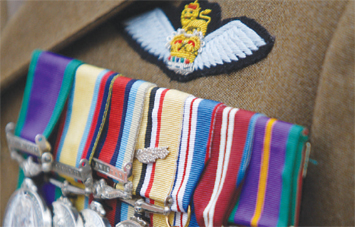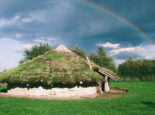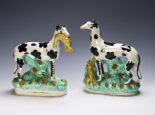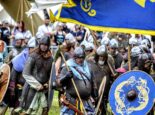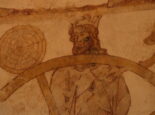Peterborough in the Great War
Peterborough in the Great War 1 2
[prev] …Ethel Bannister, aboard the RMS Hesperian when it was torpedoed off Ireland while she was en route to Canada to visit her sister in September 1915. Responsible was U-20, the same submarine that had sunk the Lusitania four months previously. As an aside, also on board was the coffin of Frances Stephens, the widow of Canadian politician George Stephens. She’d been lost when the Lusitania went down and her body was being shipped to Montréal in order to be buried beside her husband. She therefore had the dubious distinction of being sunk twice by the same U-Boat and commander, despite having being killed in the first attack.
Another woman with a connection to Peterborough who died as a result of the conflict was Edith Cavell. Although born near Norwich, she went to school in Peterborough as a teenager. As a nurse in occupied Brussels, she sheltered allied soldiers and helped them escape to the neutral Netherlands, for which she was executed by the Germans in October 1915. Her notorious death made her probably the most famous British female casualty of World War One. She is commemorated by a plaque inside Peterborough Cathedral, as is Sergeant Thomas Hunter, known as The Lonely ANZAC. Although born in County Durham, Thomas emigrated to Australia in 1910 but as a soldier of the Australian and New Zealand Army Corps, was mortally wounded during the Battle of the Somme in France during 1916. En route to a military hospital in Yorkshire by train, he was taken off in Peterborough in a critical condition and rushed to the nearby hospital (now the museum building) but died the following day. Hundreds turned out for his funeral and public subscription paid for a granite cross on his grave plus the brass memorial in the cathedral.
‘A lot of people made a fuss because he was emblematic of their own who were away fighting at the time,’ believes Stuart. ‘People felt very sorry for this young man who died so far from home and were therefore determined to honour him in a way they hoped their own would also have been treated. It was an opportunity to pay that kind of respect.’
“What made Peterborough stand out is that the Mayor was forced to read the Riot Act, threatening to summon troops unless the mob dispersed…”
The exhibition also includes industries in the city, which promptly turned themselves over to war effort in 1914. The engineering firm of Peter Brotherhood, based in Peterborough from 1906, produced shells, sea mines and torpedoes, while the Sage company, based at Walton, made the radical switch from cabinet making (having fitted out large parts of Harrods in London) to aircraft production. Elsewhere, what is now Baker Perkins made armaments, engines and spare parts for the first tanks. At the start of the war, the company was known as Werner, Pfleiderer & Perkins Ltd due to an earlier merger, but changed its name to just Perkins Engineers Ltd due to anti-German feelings. Even the Royal Family – the House of Saxe-Coburg and Gotha – eventually felt compelled to alter its title to Windsor.
In Peterborough, this led to one of the darker episodes in the city’s 20th century history. ‘There had been a German community living in the city since the 1870s, including the Frank family who owned the only recently closed butcher’s shop in Westgate,’ says Stuart. ‘They’d been perfectly well-accepted, to the extent that there was even a German oom-pah band in the city.’ But such was the outbreak of patriotic feeling in August 1914, amid tales of German atrocities, that there were riots lasting four days targeting German-owned businesses and homes. ‘The Frank family was particularly in fear of their lives, as rumours had gone around that Mr Frank was a traitor sending information back to Germany. While such scenes happened elsewhere, what made Peterborough stand out is that the Mayor was forced to read the Riot Act, threatening to summon troops unless the mob dispersed.
This is believed to be the last time the Act was read in England. The ringleaders were arrested and sentenced to hard labour, although, Stuart points out, ‘most of them were given the option instead to join up. The magistrate basically said, if you’re so patriotic and you want to go and fight Germans, you can do so or go to prison instead. Most of them did join up. Amazingly they all survived. It’s a remarkable story, really.’
“The Women’s Temperance Society was concerned with the troops, either on their way to the front or coming back on leave, who would find themselves with an hour or so to kill between trains and go and get tanked up”
Peterborough’s status as an important railway centre at the start of the 20th century has inspired aims for a further exhibition in 2018. ‘We have two books in the city’s archives that are the 1916 and 1917 registers from the Peterborough Women’s Temperance Society, which was one of the organisations concerned with the level of drunkenness,’ explains Stuart. ‘Peterborough had a huge amount of bars and it was well-known for drunkenness, especially on market days. The Women’s Temperance Society was concerned with the troops, either on their way to the front or coming back on leave, who would find themselves with an hour or so to kill between trains and go and get tanked up. So they set up stands at the stations to serve tea and coffee and turn men away from the evils of the demon drink.’ Troops could sign a visitors’ book on the stands, and while one will be on display at this year’s exhibition, the ultimate plan is to use volunteers to transcribe both volumes and research the people in them. ‘They were men from all over the country and from beyond who wrote in these books. Some just left their name, but others left little messages, poems, cartoons, all sorts of things, so it’s a snapshot of all these men passing through Peterborough.’ The hope is a new exhibition can be installed, using digital technology to project the information on the walls of the art gallery within the museum, combined with voice overs. ‘It’s a really interesting project and we’re quite excited about it,’ says Stuart. ‘There’s a huge amount in the media at the moment because it’s the centenary,’ sums up Stuart. ‘What we’re hoping to do with this 2014 exhibition and all the events and activities is to show the local level. You can lose the true message of the First World War, the real stories of the horror and the heroism, and this has a very human dimension that brings it home. These people were not just some dim and distant figures we see in a photograph or footage, but were like you and me, who came from this city. And when you look at them, you realise they’re from the street that you live in.’
Exhibition supported by funding through the SHARE Museums East Network.
Peterborough in the Great War 1 2



